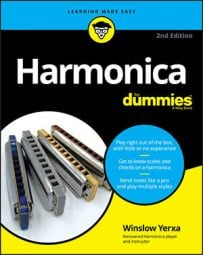When you articulate a note, you give it a definite beginning, or attack. On the harmonica, your tongue can articulate at least three different ways, and you can combine the different tongue sounds for rapid, crisp articulation.
The tongued T and L sounds
Try saying, “Aaaaaaaa,” simply sustaining a long “ah” sound.
Now try saying the same sound but interrupt it a few times by touching the tip of your tongue to the roof of your mouth to make a “T” sound. It should sound like “AaaTaaaTaaaTaaa.” Instead of one long “Aa” sound, you’re articulating that long sound into a series of distinct notes.
This “T” articulation is the crispest articulation you can execute. This is partly because you’re moving very little air between the tip of your tongue and the reed, so the effect occurs quickly as it travels a short distance. However, the tone of the note also brightens as you move the tip of your tongue near the roof of your mouth.
When you make the T sound, you completely block the airflow in your air column. However, when you make the sound of “L,” you touch the tip of your tongue to the roof of your mouth, but you let airflow to the right and left of the tip.
You can use the L sound all be itself, but its real value is in combining with the T sound to create very rapid articulation. Try saying “Diddle, diddle, diddle, diddle,” running the words together in a continuous stream.
When you say the “dl” part of the word, the tip of your tongue stays on the roof of your mouth, and you release the sides to transition from “d” to “l.” Because the motion is so small, you can make it very rapidly.
The tongued P sound for tongue blocking
What if you’re tongue blocking, with the tip of your tongue on the roof of your mouth? You can’t make the T or L sounds. However, you can create an equally crisp articulation with a tongued P.
Try doing this without a harmonica. Place the tip of your tongue between your lips, with an opening at the right corner of your mouth. Say “Aaaaaah.” Now try saying “AaaaPaaaPaaaPaah.” Notice how you make the P sound by letting the corner of your mouth touch the right edge of your tongue to momentarily stop the airflow. Now try it with a harmonica.
The tongued K sound
Try saying “KaaaKaaaKaaaKaaa.” Every time you raise the middle of your tongue to the roof of your mouth, you block the airflow. The K sound results when you lower your tongue and let the airflow continue.
The K attack sounds different from both T and tongued P. It’s a bit less smooth. It’s also an articulation you can do with your tongue on or off the harp, making it very versatile.
The K sound is one of the gateways to note bending.
Double and triple tonguing
When you need to repeat a note very rapidly, you can often execute the articulations faster if you use double tonguing by alternating between two different tongue articulations. The “Diddle” articulation is a form of double tonguing. So are “Takataka” and “Pakapaka” (when you’re tongue blocking).
Triple tonguing is when you use two types of articulation in a three-part cycle to create a series of three notes. You can create a triple-tonguing effect with “Diddle-Lah, Diddle-Lah”; with “TaKa-Ta, TaKa-Ta”; and with the tongue-blocked “PaKa-Pa, PaKa-Pa.”
You can also alternate tongued articulation with throat articulation to create subtle and varied versions of double and triple articulations.
You can hear examples of these tongue articulations on the harmonica in Chapter 6, Audio Track 0605.

